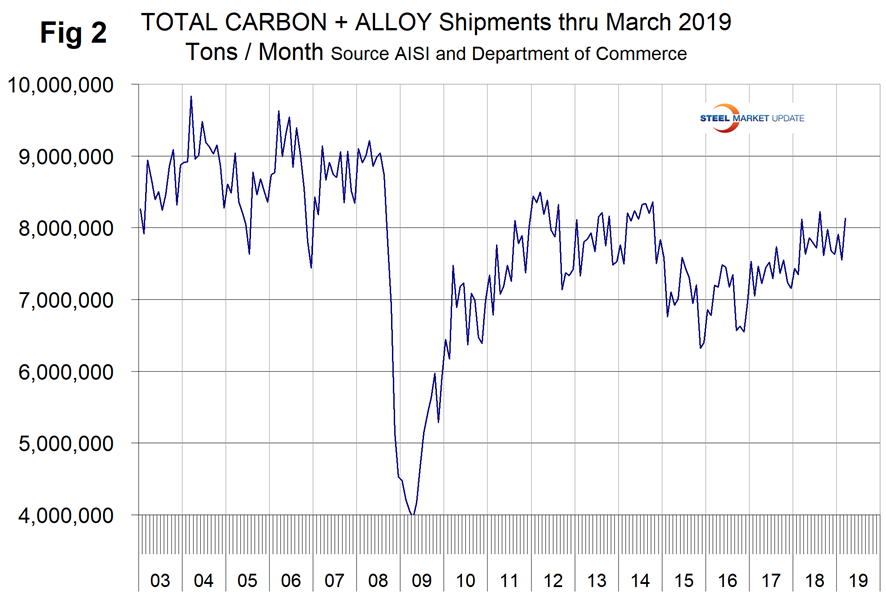Market Data

May 20, 2019
Shipments and Supply of Total Steel Products Through March
Written by Peter Wright
Demand for long products and tubular goods have shown strong growth, but sheet products are declining.
This analysis by SMU staff is based on data from the American Iron and Steel Institute (AISI) and the U.S. Department of Commerce (DoC).
The analysis summarizes total steel supply by product from 2003 through March 2019 and year-on-year changes. The supply data is a proxy for market demand, which does not take into consideration inventory changes in the supply chain. Our analysis compares domestic mill shipments with total supply to the market. It quantifies market direction by product and enables a side-by-side comparison of the degree to which imports have absorbed demand.
Figure 1 shows that the robust growth of U.S. raw steel production that occurred last year has slowed in 2019, but is still a positive 6.6 percent year over year through May 11. This is a four-week moving average and is based on weekly data from the AISI.

The shipments and supply report that you are reading now is based on monthly shipments by product, as reported by the AISI, plus import and export data from the DoC. Figure 2 shows the monthly shipment data for all rolled steel products. In the long run the trajectories of growth in Figures 1 and 2 are basically the same.

First, though, we will look at the shipment and supply situation for all product groups to see how much difference there is between them. Table 1 is this compilation. Total supply (proxy for market demand) as a three-month moving average (3MMA) was up by 5.6 percent year over year and mill shipments were up by 3.2 percent, meaning that imports took a bigger slice of the pie in the three months through March year-over-year. There is a big difference between products. Sheet products had a year-over-year decline in both shipments and supply. The domestic tubular mills made big gains over imports. The domestic plate producers lost ground to imports. Long products have very strong growth of both shipments and supply that is driven by the construction industry.

Now let’s look at sheet products in detail. One consideration is that demand in March has on a 10-year historical average been up by 9.6 percent from February. This year, March was up by 8.5 percent, therefore quite normal. Figure 3 shows the seasonality that has existed since January 2010.

Table 2 describes both apparent supply and mill shipments of sheet products (shipments includes exports) side by side as three-month averages through March with year-over-year growth rates for each. Comparing the year-over-year time periods, total supply to the market decreased by 5.3 percent and mill shipments decreased by 5.4 percent. Table 2 breaks down the total into product detail and shows that both supply and domestic mill shipments were down year-over-year on all sheet products except other metallic coated (mainly Galvalume). Apparent supply is defined as domestic mill shipments to domestic locations plus imports. In the three months through March 2019, the average monthly supply of sheet and strip was 4.597 million tons. There is no seasonal manipulation of any of these numbers. By definition, year-over-year comparisons have seasonality removed. Table 2 shows the change in supply by product on this basis through March.

Figure 4 shows the long-term supply picture for the three major sheet and strip products, HRC, CRC and HDG, since January 2003 as three-month moving averages.

Table 3 shows that total supply of sheet and strip products including hot rolled, cold rolled and all coated products, decreased by 5.3 percent year-to-date and by 0.4 percent comparing three months through March with three months through December.

SMU Comment: It’s now well into May and the latest information we have for shipments and supply is for March. AISI puts out weekly data for crude steel production, the latest of which is shown in Figure 1 for the week ending May 11 on a four-week moving average basis. In the last two months, production has been higher than at any time since mid-2012, but is still not great compared to the pre-recession level.







